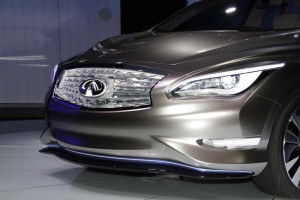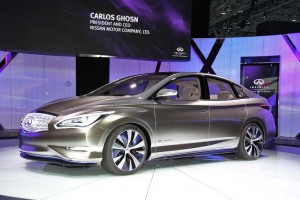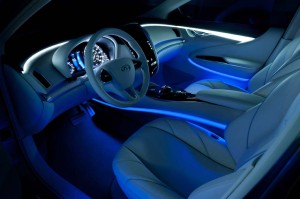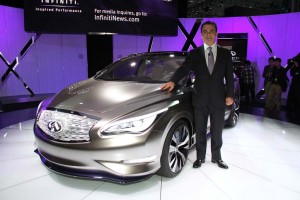Following the lead of its mainstream sibling Nissan, the upscale Infiniti brand is about to charge into the battery-car market.
Confirming an earlier report on TheDetroitBureau.com, the Japanese maker unveiled its LE Concept battery-electric vehicle, or BEV, at the 2012 New York Auto Show, Nissan CEO Carlos Ghosn promising the production model will follow “within 24 months.”
Though the Infiniti LE is based on the same platform as the Nissan Leaf battery car it would be hard to tell at first glance. The Infiniti model is lower, sleeker – and faster, “designed to stimulate,” not just transport, emphasized Ghosn, who proclaimed that with the upcoming addition to Infiniti’s line-up, the production LE will prove “luxury (can) be both desirable and sustainable.”
The maker is holding back on many of the technical details but Ghosn said the concept is “85% accurate” to what the production LE should look like. There will be relatively minor exterior changes, added Andy Palmer, Nissan’s corporate director of sustainable mobility, pointing to a grille that was clearly designed for the auto show rather than the showroom.
In an exclusive interview, Palmer told TheDetroitBureau.com that, “I had to stop the program three times because I didn’t think (earlier designs) looked like an Infiniti should.”
In its current form, the compact sporty design carries many key Infiniti design cues, such as the crescent-shaped rear pillar, as well as Infiniti’s LED head and taillights. The LE has a wind-slick drag coefficient of 0.25 – “significantly better” than the Nissan Leaf, according to Palmer, largely because it sits much lower to the ground.
“The real challenge” designing the Infiniti LE, he explained, was going from Leaf’s high hatchback form to the low and sleek sports coupe styling unveiled at New York’s Jacob Javits Center.

The Infiniti LE Concept is "85%" production-ready, though details, such as the grille, will likely be revised.
Critically, “it doesn’t scream ‘electric vehicle,’” added Ben Poore, Infiniti’s general manager.
The production version is likely to carry over some of the new technology found on the LE Concept, including both its self-parking capabilities and its induction-based charger. That would allow the battery car to automatically position itself over a special pad that would be able to provide power to recharge the batteries without actually having to plug the LE in. Nissan anticipates that using 220-volt power the system would be able to recharge the LE in about 8 hours.
The induction system may be made standard, Palmer hinted, though a final decision hasn’t been made.
Nor has Nissan formally locked down the size of the production LE’s lithium-ion battery pack. The Concept’s design provides space for as much as 26 kilowatt-hours, compared to the current 24 kWh in the Leaf. The key is to ensure that the Infiniti battery car gets close to 100 miles per charge even though it will deliver much better performance than Nissan’s leaf.
“It’s a debate over cost versus range,” said Palmer.
Something under 9 seconds 0 to 60 appears to be the target for the Infiniti LE, according to corporate sources, several seconds faster than the Nissan Leaf.
Barring a delay, the production version of the Infiniti LE battery-electric vehicle should be ready in time for the 2014 NY Auto Show.



